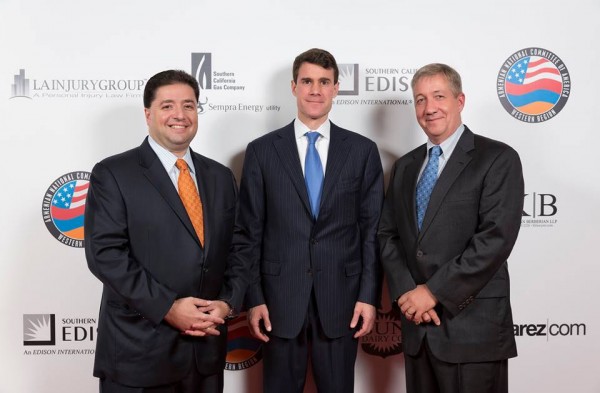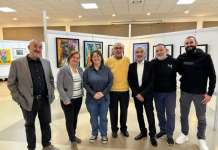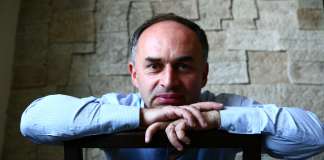MUST-SEE EXHIBIT OF NEAR EAST RELIEF AT GENOCIDE CENTENNIAL IN WASHINGTON DC
BY FLORENCE AVAKIAN
A fascinating exhibition, entitled, “They Shall Not Perish – The Story of the Near East Relief”, will be one of the not-to-miss events taking place during the three-day Genocide Centennial in Washington D.C. at the Marriott Hotel, from May 7 to May 9.
This traveling exhibition with 27 panels has already been displayed in Los Angeles and Boston, and will feature the origins and dedicated work of the Near East Relief for the one million refugees it aided during and after World War I, mostly 80 percent of which were Armenians, with the rest being Greeks, Syrians and other minorities.
This remarkable endeavor, stated Shant Mardirossian, the dedicated Chairman of the Board, (a volunteer position) of the Near East Foundation, began on July 16, 1915, when American Ambassador in Constantinople sent a cable to the State Department. “Deportations and excesses against peaceful Armenians are increasing, and from harrowing reports of eye witnesses, it appears that a campaign of race extermination is in progress under the pretext of reprisal against rebellion”, he wrote.
In another cable a few weeks later, Morgenthau declared, “the destruction of the Armenian race in Turkey is rapidly progressing,” and he urged Secretary of State Robert Lansing that a committee be formed “to raise funds and provide means to save some of the Armenians and assist the poorer ones to emigrate.”
BIRTH OF CITIZEN PHILANTHROPY
The heroes called upon in this pioneering endeavor included industrialists and philanthropists Cleveland H. Dodge, Charles Crane; YMCA head John R. Mott; Armenian speaking, long-time missionary in Harpoot, Turkey, James L. Barton who was the Foreign Secretary of the American Board of Commissioners for Foreign Missions in Boston; and head of the Reformed Zionist Movement in NY Rabbi Stephen Wise.
Within two weeks of Morgenthau’s telegram, Cleveland Dodge who was a Princeton University classmate and friend of President Woodrow Wilson, convened a meeting in his office, and the Committee on Armenian Atrocities was born.
In 1919, the organization named the Near East Relief was incorporated by an act of Congress. “The initial objective was to raise $100,000 which would be sent to Morgenthau to help some of the refugees to come to the United States,” related Mardirossian. Almost immediately, the Rockefeller Foundation funded half the amount, while the Committee members provided the rest.
“It was the birth of Citizen Philanthropy, with citizens coming to the aid of the victims,” said Mardirossian. “A sophisticated national fundraising campaign was implemented across hundreds of communities in America. An unprecedented $117 million in funds and supplies were raised during the 1915-1930 period, which in today’s standards would represent over $2 billion.”
COUNTLESS ARMENIANS SAVED
A 1922 New York Times article cited a Near East Relief report to Congress that at least one million lives had been saved, with 132,000 orphaned children rescued, fed, clothed and housed throughout its vast network of schools, orphanages, and vocational training centers across the Middle East, mostly Armenians, but also Greeks and Assyrians.
In 1925, 400 girls from the Ghazir Orphanage in Lebanon wove a thank you carpet which was presented as a Christmas gift to President Calvin Coolidge which recently was put on view for a brief period.
“Countless Armenians can trace their lives or those of their parents and grandparents back to NER orphanages and camps,” said Mardirossian who lost immediate family members on both his mother’s and father’s sides. His paternal grandmother and her siblings, however, were saved in one of the NER orphanages where they lived for four years.
“The Near East Relief, believing that its relief work ended in 1930, changed its name and mission to the Near East Foundation, and since then has worked in more than 40 countries, assisting millions of people in the Middle East and Africa,” Mardirossian reported. Today, it has projects in nine countries, including Armenia.
Shant Mardirossian revealed that the Near East Foundation is about to launch a NearEastMuseum.org which will contain digital images from the archives at the Rockefeller Archive Center in Tarrytown, NY.
“Part of the reason that the Near East Relief is so important to me,” he declared, “is because it reflects an American tradition of humanitarianism which we as Armenians benefitted from during the darkest time of our history. We of all people should reflect on this and consider the suffering of others today, and how we might alleviate it. This is the essence of the mission of the Near East Foundation.”














